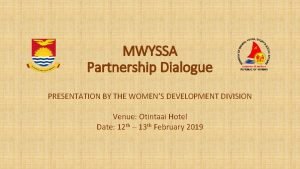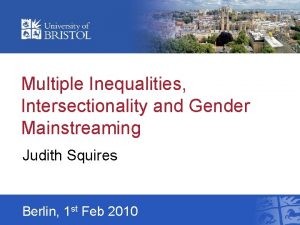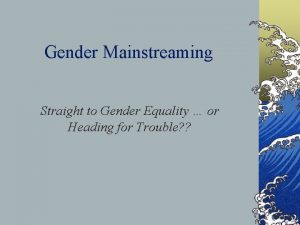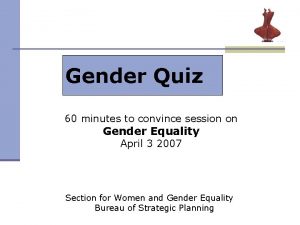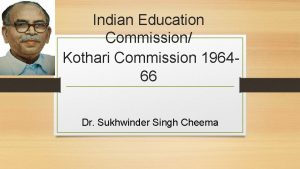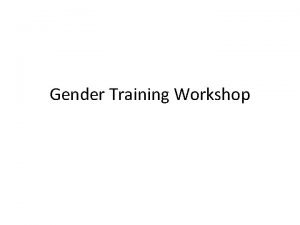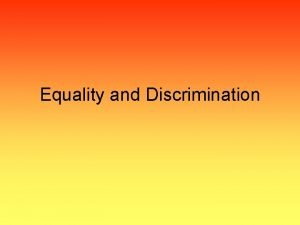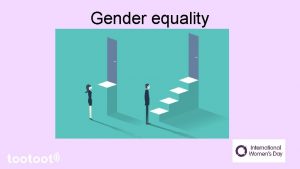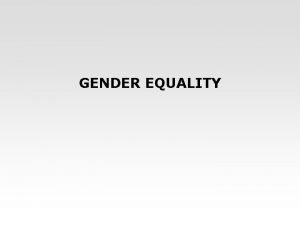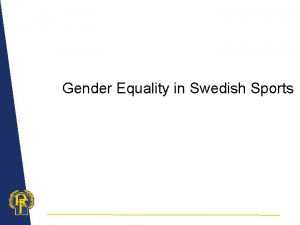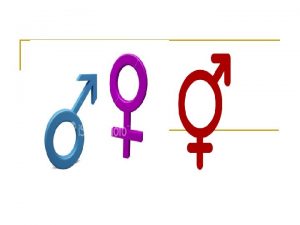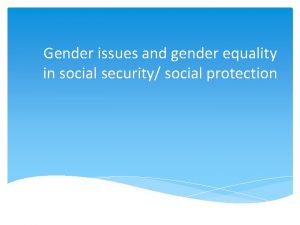SOCIAL POLICIES Education and Gender Equality Policies Second












- Slides: 12

SOCIAL POLICIES (Education and Gender Equality)

Policies • Second Five Year Plan: focused on children and education (literacy rates) • Rural Health Reforms – increase in number of qualified doctors – increase in number of hospitals – clean water more widely available • Adult literacy • Income increase

Statistics • 1. 9 million people passed a basic reading/writing test in 1975 • Children in primary education rose from: 825, 000 in 1967 to 1, 532, 000 in 1975 – Children entering school for the first time: 1967 was 187, 537 and in 1976 was 665, 621 • Increase in Rural health centers from 42 in 1967 to 152 in 1976 – Average Life expectancy raised 35 -40 in 1961 to 47 in 1976 • Adult literacy rate was at 85%

Gender Equality • School enrollment rate was higher for girls(81% in 1991) than for boys • Patriarchal society • Four Areas of Discrimination: – Women could not own land – Women could not inherit land – Women not put in charge of crops, but had to provide food for the family

Assessment of Nyerere • -Julius Kambarage Nyerere was born on April 13, 1922. He was a Tanzanian politician who served as the first President of Tanzania. He was in office from 1961 to 1985. • -He was to college at Makerere University and University of Edinburgh. Once he graduated he worked as a teacher. In 1953, he helped form the Tanganyika African National Union. • -In 1961, Nyerere was elected Tanganyika's first Prime Minister, and following independence, in 1962, the country's first President. •

• -In 1965, a one-party election returned Nyerere to power. The first couple of years he created a single party system and planned to eliminate trade unions and opposition. • -Later in 1965, he implemented a socialist economic program; it was made to establish ties with Mao and china, and to also introduce a policy of collectivization in the countries farming system. • -In the early 1970 s, Nyerere had most of the population be moved to collective farms. The campaign pushed the nation to almost complete starvation which made it dependent on foreign food aid. • -In 1985, after over 20 years in power, Nyerere retired and he chose someone to take his place. • -In 1999 he died of Leukemia while in London.

• Wanted to get rid of capitalism and nationalize banks and large industrial concerns and put them under government control. • • Ujamaa villages were created to focus on traditional African values of community and family and make Tanzania a socialist, self-reliant nation. • • Profit gained belonged to the Ujamaa village and violent confrontations came out between the government troops and rebellious villagers. • Government had to force peasants into migration because they preferred to work their own individual plots of land. • • Villages not producing output needed for Tanzanian economy to grow. •

• Grain produced was not enough to feed population. Crisis in maize production, led to decline in cash crop exports, had to import quantity of maize. Cotton exports fell and Tanzania become more and more dependent on overseas loans. • • Tanzanias main export sisal (used to make ropes and twines) dropped from 35% export earnings to less than 1%. • • The production of cash and food crops led to a rapid increase of inflation and the government was threatened with bankruptcy. •

• Passed the Ujamaa Villages Act in 1975 which increased minimum size to 250 families. • • Importing of oil rose from 10% of export earnings to nearly 40 by middle 1980 s, and food production at bad levels due to poor weather and corruption, and factories were under-utilized operating below capacity. • • GDP averaged 1. 7% between 1980 and 1987, and in 1970 the debt went from $250 million dollars to $3. 7 billion •

ECONOMIC DEVELOPMENT • • • 1 st: 1964 -69 2 nd: 1969 -74 3 rd: 1976 -71 4 th: 1981 -1986 Five year plans aimed at eliminating the three main issues of Tanzania’s economy: 1) Poverty 2) Disease 3) Ignorance

ECONOMIC DEVELOPMENT • 1 st Five Year Plan’s goal: stimulate economy to produce 6. 7% increase in gross domestic product • Economic growth of 5. 3% after First Five year plan, although it didn't reach Nyerere's goals • Population increase along with less than favorable economic growth forced Nyerere to reevaluate outside help from foreign country when funding his Five Year Plans

ECONOMIC DEVELOPMENT • 1966 -Nyerere turned away from foreign aid. It often arrived later than the Tanzanian economy needed; with large debts that further pushed the economy off balance • Nyerere pushed self-sufficiency in order to repair the Tanzanian economy. He hoped to rebuild without the constant reminder of debt over their country and without isolating themselves from the rest of the world.
 Strategic gender needs and practical gender needs
Strategic gender needs and practical gender needs Gender equality is more than a goal in itself
Gender equality is more than a goal in itself Rhetorical questions about gender equality
Rhetorical questions about gender equality Gender equality definition
Gender equality definition What is gender equality answer
What is gender equality answer Methodology of gender equality
Methodology of gender equality Structure of kothari commission
Structure of kothari commission Poem about gender equality
Poem about gender equality Example of gender equality
Example of gender equality Slogan about discrimination
Slogan about discrimination What is gender equality answer
What is gender equality answer Substantive equality vs formal equality
Substantive equality vs formal equality Formal and substantive equality
Formal and substantive equality

